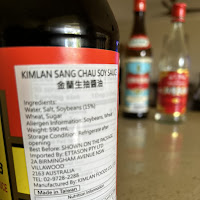Last night I made a family dinner of a westernised restaurant favourite - Sesame Chicken. I followed Mandy’s method from Souped Up Recipes. All the shops are closed on Good Friday, so I was pleased to see I had everything in my pantry that the recipe called for.
And this got me thinking about my must-haves from my local Asian supermarkets.
Sauces
- Light soy sauce
- Dark soy sauce
- Sweet soy sauce (kecap manis)
- Fish sauce
- Oyster sauce
Choosing
As with all the foundational sauces, vinegars and cooking wines, you start by looking at the ingredients. The fewer ingredients the better.
Soy sauce is soy sauce - why would it need flavour enhancer this or colouring that? Unless they’re using low quality soy… For soy sauce, also look for ‘naturally fermented’ on the label.
There are grades to most of these - premium, superior and whatnot. The most impactful on the flavour is ‘premium’ for oyster sauce. Premium oyster sauce is much, much tastier than its regular counterpart, in this case (top image) brand Lee Kum Kee.
Wines and vinegars
- Dark cooking wine (shaoxing - also spelled shao hsing)
- White cooking wine (shiwan from Pearl River Bridge is good)
- White rice vinegar
- Black vinegar
Choosing
Follow the ingredients rule. The wines will often come in salted or unsalted versions. They’re both fine. The ingredients of my white cooking wine are: water, rice, salt; while the darker is: water, rice, wheat. What you don’t want to see is ‘alcohol’. That means it’s not wine at all, but a bunch of flavouring with alcohol added.
Black vinegar: White rice vinegar can be satisfactorily substituted with European white vinegar, but there is no substitute for delights of Chinese black vinegar.
I’ve found products labelled ‘black vinegar’ to be particularly susceptible to imposters. One I bought without checking had about 12 ingredients which, from memory, included carrots. Just a cocktail of flavours made to mimic the real thing. Look for: water, black glutinous rice, wheat, salt.
Oils
- Canola oil
- Peanut oil
- Sesame oil
- Ghee
For general use, I like canola oil best. It does the trick, and its flavour is unintrusive. It’s also safer if you’re not sure of the allergies of the people you’re cooking for. Peanut oil has a stronger flavour, and it just depends on how I’m feeling.
With sesame oil, just remember a little goes a long way. It’s not a cooking oil, it’s an flavouring oil and great for dipping sauces. In a stir fry - add it last. Right at the end. Just before serving.
As with black vinegar, there is no substitute for ghee. A South Indian curry made with ghee will taste sooo much better than one made with vegetable oil.
Other stuff
- Palm sugar
- Chilli bean sauce (toban djan)
- Chicken bouillon powder
- MSG
Some might say that brown sugar is an acceptable substitute for palm sugar. They are wrong. It’s not terrible. But palm sugar is much better in Thai, Indonesian and Filipino cooking. Toban djan is just great stuff - a staple of Schezwan food A little of this can do wonders for a basic veggie stir fry.
The absence of chicken bouillon is why so many people ask - why doesn’t my fried rice taste like takeout?
MSG is a much maligned flavour enhancer, but the serious negative health effects it’s been blamed for are debunked. It has been used in many Asian cuisines for more than a century.
Go-to channels
Chinese cooking demystified
Steph and Chris explore the many cuisines of China. Often the recipes come with a little social history.
Souped up recipes
I’ve followed this since Mandy first moved from China to South America (she’s now based in North America) in search of a warmer climate to help her arthritis. Again, mostly Chinese, including ‘international’ Chinese.
School of wok
Jeremy is a very charming presenter. His technique of arranging stir fry ingredients in a ‘wok clock’ changed the way I cook.
Pailin’s kitchen
In the late 1980s, the Pailin (no relation), on Parramatta Road, was at the forefront of the explosion of Thai restaurants in Sydney. So I’m fond of that name.
Also known as ‘Hot Thai Kitchen’, it includes neighbouring cuisines. As Pai says - let’s get started!

